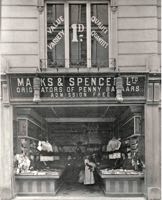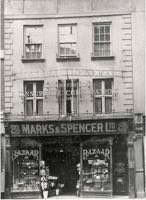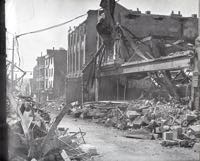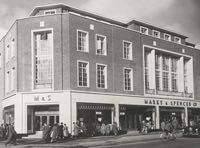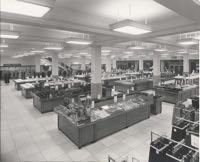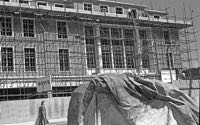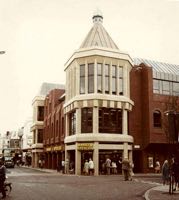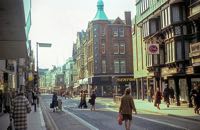
Marks and Spencer
Page updated 1st January 2019
Return to Retail Exeter
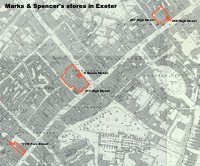 One of the most trusted high street brands, Marks and Spencer has come a long way from its humble beginnings in Leeds. But to understand the stores presence in Exeter, we need to go back to 1884 when a young Russian Polish emigre arrived in Leeds, searching a better life. Michael Marks, met Isaac Dewhirst, a local owner of a textile business. Dewhirst loaned Marks the money to purchase stock, no doubt from his warehouse,, and Marks opened a market start in Kirkgate. He differentiated his business from others with the slogan 'Don’t ask the price, it’s a penny.’ (1)
One of the most trusted high street brands, Marks and Spencer has come a long way from its humble beginnings in Leeds. But to understand the stores presence in Exeter, we need to go back to 1884 when a young Russian Polish emigre arrived in Leeds, searching a better life. Michael Marks, met Isaac Dewhirst, a local owner of a textile business. Dewhirst loaned Marks the money to purchase stock, no doubt from his warehouse,, and Marks opened a market start in Kirkgate. He differentiated his business from others with the slogan 'Don’t ask the price, it’s a penny.’ (1)
Marks met Tom Spencer, who worked for Dewhirst as a book-keeper, in 1894. Spencer invested £300 for a half share in a partnership, known as Marks and Spencer. In 1903 the business became a limited company. By 1904, Marks & Spencer, takes eight units in the new Cross Arcade, Leeds. The business suffers a setback, when Tom Spencer dies in 1905. Two years later, and Michael Marks dies at the age of circa 43. (1)
The first Exeter stores
The company expanded, opening Penny Bazaars across the nation. The first Penny Bazaar in Exeter opened in 1912 at 5 Queen Street. The store sold haberdashery, sewing equipment, biscuits, toys and sheet music, but no clothing. One of the innovations of the stores was that customers could see everything on display on tables, without asking an assistant to look behind the counter. A second store opened in 1917 at 259 High Street, while the Queen Street branch closed in 1919. (4)
The addition of clothing in the late 1920s, required a new, larger store and on 30 August 1929, they opened at 177-8 Fore Street, approximately where BHS were situated, opposite Wetherspoons, Chevalier Inn. Trade was good, and the store was extended in November 1935 and again, in July 1936. A cafe-bar was added in the early war years. (1)
Lost in the blitz
The top of Fore Street was very badly damaged in the blitz of the 4 May 1942, when it had a direct hit from a high explosive bombed–the remains were gutted by fire caused by incendiary bombs. All the buildings from Mary Arches Street up to Brock’s Furnishings were destroyed, including Marks and Spencer. (3)
The official fire report at the time stated:
Messrs Marks and Spencer in Fore Street was a modern steel framed structure. The fireguards were ready to deal with incendiary bombs but they were presented with a heavy high explosive bomb which shattered their building and set it on fire. (3)
It was nine years before a replacement Marks and Spencer was built, this time, at a prime location on the corner of Castle Street, at 247 High Street. The store had an area of 23,300 square feet on two storeys, and a frontage of 110 feet. It included a cafe-bar, an innovation that lasted until 1961, when it was the last, along with the Leeds branch, to be closed. In September 1972, the store was enlarged, increasing the frontage to 130 feet and adding 1,200 square feet to the total. (1)
In 1956, the St. Michael News reported that supervisor Mrs. Baglow was given a six-penny piece by an elderly gentleman who stated:
“You see in 1911 I stole some marbles from one of your Penny Bazaars. Funny thing, but I’ve worried about it ever since. I’ve always enjoyed shopping and walking around your wonderful stores and I want to do it with an easy mind!” (1)
In November 1958 the store opened hairdressers. The Express and Echo featured the opening on the main page picturing Shirley Coles having her lunch under the drier while talking to hairdresser Mrs. Coin, with the headline “The store already has a chiropody, dental and medical service for its staff. What next?” (2)
Another move
The store was continuously improved, and an escalator was installed in 1964. However, by the 1970s, plans were afoot to close 247 High Street and move into larger premises, on the edge of the Golden Heart project that was being built behind the Guildhall. The company acquired the premises on the corner of Queen and High Street that was formerly Waltons Department Store which had closed in 1972. Negotiations for the land and planning permission took tree and a half years, while the build was 18 months.
Although the original octagonal dome on the corner was retained, along with a facsimile of the white Queen Victoria statue (5) on the roof, other interesting architectural features were lost, despite promises they would be retained. The new store at 211/217 High Street opened in May 1981, with 43,600 square feet over three floors. The store was extended in 1986 by 13,100 square feet. Voluntary work by the staff saw the Marks and Spencer float in the Exeter carnival parade of 1987 win Best Commercial Float and Best Theme award.
A fire
In February 2011 a disgruntled employee broke into the store and set fire to clothing in the lingerie department on the first floor. The store was mostly smoke damaged, requiring to be closed for several weeks. (2)
The company opened a food hall at 4, Exe Bridges Retail Park in December 2011. Since then the changing face of the High Street forced by the growth of online sales has seen once well established chains cutting back or closing altogether. Marks and Spencer in Exeter has escaped this trend so far, and will no doubt innovate its sales pitch to survive increasingly difficult times for bricks and mortar retailing.
Sources: (1) M&S Company Archive, (2) Express and Echo, (3) Official Records taken after the May 1942 blitz, and (4) various street directories, (5) Exeter Memories.
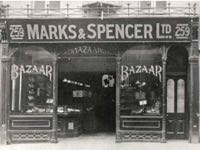
In 1917, Marks and Spencer opened their second store in the city at 259 High Street. Courtesy the M&S Archive.
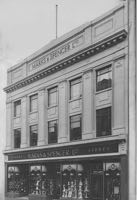
The first purpose built store in Exeter opened in 1929 at 177 Fore Street. Courtesy the M&S Archive.
│ Top of Page │
